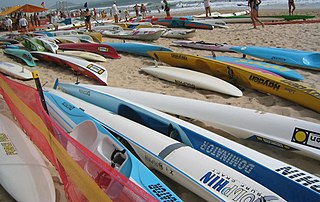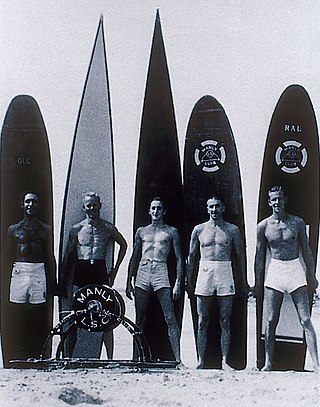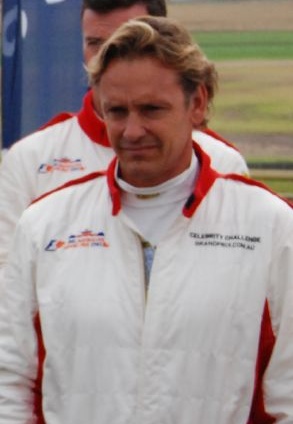Related Research Articles

A triathlon is an endurance multisport race consisting of swimming, cycling, and running over various distances. Triathletes compete for fastest overall completion time, racing each segment sequentially with the time transitioning between the disciplines included. The word is of Greek origin, from τρεῖς or treis (three) and ἆθλος or athlos (competition).

Surf lifesaving is a multifaceted social movement that comprises key aspects of voluntary lifeguard services and competitive surf sport. Originating in early 20th century Australia, the movement has expanded globally to other countries, including New Zealand, Ireland, South Africa, and the United Kingdom. Surf lifesavers in Australia are colloquially known as "Clubbies".
An Ironman Triathlon is one of a series of long-distance triathlon races organized by the World Triathlon Corporation (WTC), consisting of a 2.4-mile (3.9 km) swim, a 112-mile (180.2 km) bicycle ride and a marathon 26.22-mile (42.2 km) run completed in that order, a total of 140.6 miles (226.3 km). It is widely considered one of the most difficult one-day sporting events in the world.
A quadrathlon is an endurance sports event composed of four individual disciplines. All four disciplines are completed in succession and the lowest overall time decides the winner.

A surfski is a type of kayak in the kayaking "family" of paddling craft. It is generally the longest of all kayaks and is a performance oriented kayak designed for speed on open water, most commonly the ocean, although it is well suited to all bodies of water and recreational paddling.

The Manly Life Saving Club is one of Australia's oldest Surf Life Saving Clubs, founded in 1911; located in the Sydney suburb of Manly, in the Northern Beaches Council in New South Wales.
Cory Francis Hutchings is a former world surf lifesaving Ironman champion from Gisborne, New Zealand. Hutchings was born in Gisborne to a family of passionate sportspeople. His father Ben was the coach of the New Zealand men's canoeing team who won gold in four events at the 1984 Los Angeles Olympics. Cory's involvement in surf lifesaving begun at age five.

The International Life Saving Federation (ILS) is an organisation for drowning prevention, water safety, lifesaving and lifesaving sports.

Guy Leech is a former Australian Ironman surf lifesaving champion.
The Coolangatta Gold is one of the premier events in the sport of Ironman. The event is organised by Surf Life Saving Australia.
The Lorne Pier to Pub is an annual, 1.2-km open water swimming race held in January at Lorne, a town located on the Great Ocean Road in Victoria, Australia.
Ky Hurst is an Australian swimmer and ironman. He competed at the 2008 Summer Olympics in the 10km marathon swimming event and finished in 11th place, after qualifying by finishing fifth at the 2008 FINA World Open Water Swimming Championship. Hurst was one of the first Australian athletes to gain selection for the 2012 London Olympics by placing fifth at the 2011 World Open Water Swimming Championships. At that time Hurst decided to continue to pursue both swimming and Ironman racing during 2012, the latter he competed in with great success. Hurst was a long term ward of master coach Dennis Cottrell, at the Miami Club. He is now under noted swimmer and coach Colin Braund and in Bond Club.

The Uncle Tobys Super Series was a professional Australian Iron Man circuit that ran from 1989 to 2001. It was considered by many to be the pinnacle of Surf Lifesaving and inspired many young kids to become involved in the sport. It also made the sport professional and gave the opportunity for contracted competitors to make a full-time living from the sport.
The Lion Foundation Surf League was established by Surf Life Saving New Zealand as an elite series for the top one percent of its athletes. Its purpose was to pit the best Surf Lifeguards in the country against each other to ensure that those who prevailed were the best of the best. The competition consists of 8 teams in the Open and U19 teams.
The Kellogg's Nutri-Grain Ironman and Ironwoman Series is a professional iron man and iron women racing series, born out of surf livesaving.
Daniel McLellan is a surf swimmer and life saving competitor who represented Australia on nine occasions during the 1990s. He has won numerous Australian Titles and has saved many unexpected lives other his years of profession and non professionalSLSA) and competed in Kellogg's Surf League. He also represented Australia at the World Life Saving Championships and World Interclub Championships.
Shannon Eckstein is an Australian Ironman surf lifesaving champion with his brother Caine Eckstein.
The Australian Surf Life Saving Championships known as The Aussies is the national Surf lifesaving championships for Australia. It is the largest surf lifesaving event in Australia and the largest event of its kind in the world. It is organised by Surf Life Saving Australia, and had been held annually since 1915.
The Freshwater Surf Life Saving Club, established in 1908, is located at Freshwater Beach in Australia. It has become a large volunteer organization with strong community bonds. The club was founded by a push from government to foster safer beach practices. It is a part of Surf Life Saving Australia, a not-for-profit organization committed to keeping the beach safe for patrons and providing beach rescue services. A visit to the club from United States' surfer, Duke Kahanamoku, in 1914 helped initiate the sport of surfing in Australia.
Thomas Gallagher is an Australian Paralympic swimmer and surf life saver. He represented Australia at the 2020 Tokyo Paralympics, winning a bronze medal.
References
- ↑ "History of Surf Life Saving 1907". Archived from the original on 16 November 2011. Retrieved 15 February 2012.
- ↑ "Events Surf Life Saving" . Retrieved 15 February 2012.
- ↑ "GRANT KENNY Bio" . Retrieved 15 February 2012.
- ↑ "The Coolangatta Gold IMDB". IMDb . Retrieved 15 February 2012.
- ↑ "surfironmanseries.com" . Retrieved 15 February 2012.
- ↑ "SLSA Admin & Resources". Archived from the original on 19 February 2011. Retrieved 15 February 2012.
- ↑ "Surfski.info – Getting Started" . Retrieved 15 March 2012.
- ↑ "Ky Hurst" . Retrieved 15 March 2012.
- ↑ "SLSA Admin & Resources". Archived from the original on 19 February 2011. Retrieved 15 February 2012.
- ↑ "Aussies 2012 – Surf Life Saving" . Retrieved 15 February 2012.
- ↑ "Rescue 2012" . Retrieved 15 February 2012.
- ↑ "Coolangatta Gold" . Retrieved 15 February 2012.
- ↑ "surfironmanseries.com" . Retrieved 15 February 2012.